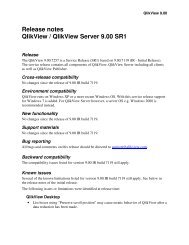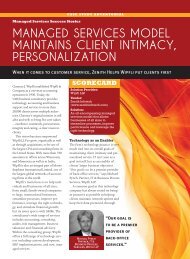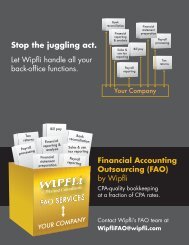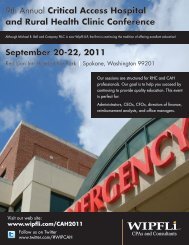Download PDF - Wipfli
Download PDF - Wipfli
Download PDF - Wipfli
You also want an ePaper? Increase the reach of your titles
YUMPU automatically turns print PDFs into web optimized ePapers that Google loves.
Uganda Update<br />
Introduction of Transfer Pricing regulations<br />
in Uganda<br />
The Minister for Finance, Planning and Economic Development<br />
in Uganda finally published the Income Tax (Transfer Pricing)<br />
Regulations, 2011. These regulations are based on provisions<br />
of Section 90 and Section 164 of the Ugandan Income Tax<br />
Act and took effect from 1 July 2011. The Ugandan Revenue<br />
Authority is joining the global trend towards laying emphasis<br />
on non-traditional revenue sources and moving towards<br />
Transfer Pricing and related party transactions. In this regard,<br />
these regulations are meant to ensure that transactions<br />
between Ugandan taxpayers and related non-resident<br />
entities are at arm’s length.<br />
Who do the regulations apply to?<br />
The Transfer Pricing regulations apply to a controlled<br />
transaction where a person who is party to the transactions<br />
is located and subject to tax in Uganda and the other party<br />
in the controlled transaction is located in or outside Uganda.<br />
The regulations define ‘a person’ to include a ‘branch person’<br />
and a ‘headquarters person’.<br />
Distinction between ‘a branch person’ and<br />
headquarter person’<br />
Under the Transfer Pricing regulations:<br />
(a) ‘a branch’ is deemed to be a separate and distinct<br />
person (branch person) from the person in respect of whom<br />
it is a branch ie the ‘headquarters person’<br />
(b) a branch person and headquarters person are deemed<br />
to be associates<br />
(c) a branch person and a headquarter person are located<br />
where their activities are located.<br />
The Arm’s Length Principle<br />
Entities entering into a transaction or series of controlled<br />
transactions in Uganda are now required to determine the<br />
income and expenditure resulting from such transactions,<br />
in accordance with the Arm’s Length Principle (ALP). Failure<br />
to do so will mandate the Commissioner to effect necessary<br />
adjustments so as to ensure adherence with the ALP which<br />
may be to the detriment of the taxpayer.<br />
Transfer Pricing methods to be adopted<br />
The Transfer Pricing methods acceptable under the Transfer<br />
Pricing regulations are consistent with the globally accepted<br />
norms under the Organisation for Economic Development<br />
and Co-operation (OECD) regulations. Entities in Uganda<br />
can adopt either of the following methods for purposes of<br />
arriving at their transfer prices:<br />
(a) the Comparable Uncontrolled Price method<br />
(b) the Resale Price method<br />
(c) the Cost Plus method<br />
(d) the Transaction Net Margin Method<br />
(e) the Transactional Profit Split method; or<br />
(f) any other method that may result to an Arm’s Length<br />
Price in a comparable controlled transaction.<br />
44 // PKF International Tax Alert All Regions<br />
Issue 8 November 2011
















